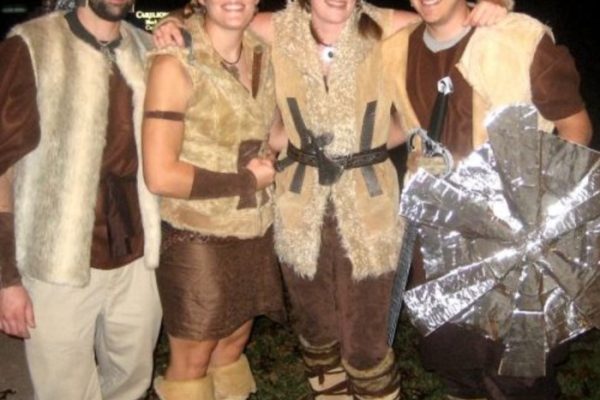Introduction to DIY Werewolf Costumes
Delving into the world of horror and fantasy can be a thrill like no other, especially during the Halloween season. Crafting a DIY scary werewolf costume offers both a challenge and an opportunity to unleash your creative beast. Before you jump into making your own werewolf getup, grasp why DIY can be your best bet for a howling success on fright night.

Embracing the DIY approach allows you to tailor the costume for a perfect fit – quite literally. When you create your own scary werewolf costume, you control the details. From selecting the ideal fabrics that provide both comfort and realism to perfecting the gory extras that send shivers down the spine, the power is in your hands. What’s more, this hands-on project can also lead to a unique and unforgettable outfit that stands out from store-bought versions.
Throughout this guide, you’ll discover the steps to assemble a costume that’s both impressive and spine-chilling. We’ll cover everything from gathering materials and crafting the base of your costume, to the intricate details that will make your werewolf appearance eerily lifelike. So, get ready to transform into the most feared creature of the night with your own homemade scary werewolf costume.
Gathering Your Materials
Before diving into the creation of your scary werewolf costume, you need to gather the right materials. You’ll want to strike a balance between durability, comfort, and authenticity. Building a convincing werewolf costume requires attention to the texture and color of the fabrics and accessories.
Choosing the Right Fabrics
Choosing the right fabrics is crucial for both the look and feel of your costume. Start with thick, dark fabrics like faux fur to mimic the werewolf’s shaggy appearance. Consider using stretchable fabrics like spandex for areas that need more flexibility. For a realistic touch, mix different shades and lengths of fur. Always opt for breathable materials to avoid overheating while you scare your friends.
Essential Accessories
No scary werewolf costume is complete without its essential accessories. Think about paws, fangs, and of course, the eyes that glint in the dark. You can find these at costume stores or make them yourself for a personal touch. Additional items like a tail made from faux fur, and belts or straps to secure the costume, should also be on your list. Remember, it’s these little details that contribute to a truly frightening werewolf transformation.
Creating the Base of Your Costume
A sturdy and flexible base is vital for your scary werewolf costume. Start with a plain bodysuit. A tight black or dark brown bodysuit serves as the perfect canvas for your werewolf look. Opt for materials like spandex or lycra for stretch and mobility. You’ll later layer fur and other details onto this bodysuit, so ensure it’s both comfortable and close-fitting.
Assembling a Bodysuit
When assembling your bodysuit, think about movement and durability. Look for a bodysuit with a zipper for easy wearing. If you can’t find the right color, dye it darker with fabric-safe dye. Test its range of motion by performing stretches and bends. Your costume should move with you, not restrict you.
Adding Muscle and Shape
To embody the werewolf’s powerful build, focus on muscle and shape. Use foam padding or upholstery stuffing to create muscle definition. Attach these to the bodysuit with fabric glue or sew them in place for a stronger hold. Shape muscles for the chest, shoulders, and thighs. Keep the padding proportional to maintain a fearsome, yet believable silhouette. Be mindful of the costume’s weight. Too much padding can slow you down and lead to overheating.
Crafting the Werewolf Head
Your werewolf costume head is the centerpiece of your transformation. The head, featuring a snarling expression, pointed ears, and piercing eyes, should look as authentic as possible. It will capture the attention and set the tone for your entire creature portrayal.
Making a Convincing Werewolf Mask
To make a convincing werewolf mask,start with a strong, lightweight base. Use materials like latex to mold the shape of the head. Focus on the distinct features of a werewolf; sharp cheekbones, a broad forehead, and a pronounced snout. Add textures to these features for a more realistic feel. Once the base is set, paint it in shades that match your chosen fur. Attach the ears high and pointed, and include room for your own eyes to see through.
For a truly haunting look, purchase or create fangs to fit into the mask’s mouth. Consider using LED lights for an eerie glow in the eyes, or mesh that allows you to see without being seen.
Realistic Fur Application Techniques
Applying fur to your werewolf mask takes patience and attention to detail. Start with longer fur on the top and back of the head, then transition to shorter fur on the face. Use a mix of fur lengths and colors for a natural, unkempt look. Attach the fur in layers, making sure to cover the entire head. Adhere it with a strong costume glue, and pay extra attention to the direction the fur lays; it should flow smoothly from one area to the next.

Trim areas around the eyes, nose, and mouth for a cleaner appearance and better functionality. Remember, the goal is to keep the mask scary, realistic, and wearable for your scary werewolf costume.
Detailing for a Frightening Finish
Once the base of your scary werewolf costume is complete, it’s time to add details that will bring your creature to life. Details make the difference between a good costume and a truly terrifying one. Here, we will focus on claws, teeth, scars, and blood effects that will intensify the horror of your creation.
Artificial Claw and Teeth Creation
For menacing claws, use sculpting clay to shape them before painting them black or a dark brown. Attach them securely to gloves or fingertips with strong adhesive. Make the claws curved and pointed for a more dangerous look. Next, craft teeth out of polymer clay or purchase a set of fangs from a costume shop. Fit them to your mouth to maintain a comfortable, yet fearsome snarl.
Adding Battle Scars and Blood Effects
Scars and blood effects can give your werewolf a backstory of past battles. Use scar wax or liquid latex to create realistic wound textures on the face or arms. Paint them with a mix of red and dark purple for a fresh, gory look. For added gruesomeness, let some fake blood drip from the corners of your mouth or claws. Dab a sponge in fake blood, and gently apply it to your costume to mimic the splatter of recent kills.
The Final Transformation
You now stand at the brink of unleashing the werewolf within. With the costume’s base, head, and frightening details all set, it’s time to complete your transformation. The final touches will bring your scary werewolf costume to life and make your appearance genuinely terrifying.
Makeup Tips for a Werewolf Look
Makeup bridges the gap between a good costume and a lifelike werewolf. Follow these makeup tips:
- Use dark shades around your eyes to create a menacing gaze.
- Add fur patches to your face with cosmetic adhesive for seamlessness with the mask.
- Apply highlights and shadows to mimic fur texture on any exposed skin.
- Use red to outline any fake wounds to enhance the illusion of depth and freshness.
Choose water-based makeup to prevent skin irritation and ensure easy removal.
Perfecting Your Werewolf Stance and Growl
How you move and sound is critical for authenticity. Practice the following:
- Lower your stance and widen your legs for a predatory posture.
- Lean forward slightly, and let your arms hang for an animalistic profile.
- Work on a deep, guttural growl that resonates from within.
- Use quick, jerky movements to mimic a creature on the prowl.
Remember, confidence in your movements will convince everyone of the werewolf you’ve become. With these final steps, your DIY scary werewolf costume will be the highlight of any Halloween gathering or themed event. Embrace the character, and have fun terrifying those who dare cross your path.
Inspiration from Popular Werewolf Movies
For a howling success, draw inspiration from popular werewolf movies. They are a treasure trove of visual cues and character traits that can elevate your scary werewolf costume from simply good to spine-tinglingly fantastic.
Analyze Werewolf Behavior
Study how movie werewolves move and react. Observe their posture, gait, and how they interact with their environment. Mimicking these behaviors can add a layer of realism to your portrayal.
Emulate Iconic Looks
Take note of the costume designs from films like ‘An American Werewolf in London’ or ‘The Wolfman’. Pay attention to the fur patterns, facial structures, and color palettes used. Integrating these elements into your costume can create a more authentic werewolf appearance.
Incorporate Signature Sounds
Don’t forget the growls and howls that make a werewolf so formidable. Listen to soundtracks and imitate these chilling sounds to complement your costume at the perfect moment.
Incorporating these movie-inspired aspects into your costume will not only enhance its scare factor but also pay homage to the classic werewolf lore that has thrilled audiences for decades.

Safety Tips for Wearing Your Scary Costume
When you don your scary werewolf costume, safety should be a top concern. Here are some tips to stay safe while you’re in character:
Use Non-Toxic Materials
Choose materials that are safe for skin contact. Avoid toxic glues and paints that can cause irritation or allergic reactions.
Keep Visibility and Mobility in Mind
Make sure your mask allows for clear vision. Trim fur around the eyes if needed. Ensure the costume doesn’t restrict movement.
Stay Cool and Hydrated
Wear breathable fabrics and take breaks to avoid overheating. Drink plenty of water, especially if you’re active or in a warm environment.
Ensure a Secure Fit
Your costume should fit well without being too tight. Use straps and belts to keep everything in place without hindering your movement.
Practice Walking in the Costume
Get used to the costume’s weight and feel before the event. Practicing can prevent trips and falls.
Careful with Makeup and Prosthetics
Use makeup that’s easy to remove and doesn’t block your pores. Test prosthetics beforehand to ensure they’re comfortable for long wear.
Have an Emergency Plan
Know how to quickly remove your costume if necessary. Carry a small emergency kit with band-aids, safety pins, and a phone.
By following these safety tips, you can focus on the fun and fright of being a scary werewolf without any unwelcome scares.





